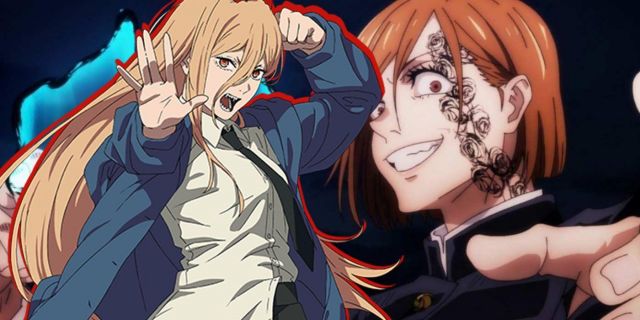Chainsaw Man is a bloody, brutal and darkly funny new anime that can be generally described as a shonen deconstruction — or at least, a partial one. At its core, Chainsaw Man is a stock shonen story with a relatable underdog protagonist, an exciting fantasy combat system and terrifying monsters to fight. The hero, Denji, even has a shonen-style main squad, but in a twisted way.
Denji’s new sidekick Power, a horned fiend, is no Sakura Haruno or Ochaco Uraraka. Power is a crude, uncooperative, self-centered and immature character who’s a headache for everyone around her, but for viewers, that’s what makes her fun. It also makes Power a double-layered subversion of the shonen trope of the male hero having a lovely female sidekick. Not even Jujutsu Kaisen’s Nobara Kugisaki went this far.
How Power Subverts Nobara Kugisaki’s Shonen Subversions

Many shonen and some seinen anime happily subvert common or worn-out tropes and clichés in exciting ways, creating something familiar yet new at the same time. To an extent, Jujutsu Kaisen did this with its character Nobara Kugisaki, Yuji’s sorcerer teammate and friend. Nobara, in elegant and inspiring fashion, firmly subverted the idea of female shonen sidekicks being mere cheerleaders or eye candy. Nobara stands firmly on her own, and she rejects everyone’s traditionalist views on what girls and women should be. On one hand, Nobara rejects the sorcery world’s regressive view of girls and women, just like Maki Zenin, but Nobara also identifies with and values her feminine side. In Nobara’s mind, she can be tough and beautiful, carving out an ideal balanced identity on her own. That’s empowering and exciting to watch, but then Chainsaw Man’s Power came along and subverted things yet again.
If Nobara is a positive subversion of regressive shonen attitudes about girls, Power is a twisted and non-empowering double subversion, all for the sake of comedy and some appropriately dark themes. Power isn’t just a strong, independent girl who rejects society’s suffocating norms. Power rejects absolutely everything, from the power of friendship and the virtue of honesty to basics such as bathing regularly or respecting boundaries. Power goes to a ludicrous but intriguing extreme to reject not just society’s expectations for girls but society’s expectations for anyone.
Power is a fiend — a devil reborn in a human body — so her humanity is only skin-deep. It’s refreshing to see a character like Power go wild and break every last rule while enjoying her independent lifestyle, but it also reminds viewers that Power is a tragic creature who has no real place in the world. Power breaks the rules not just for fun but because society and its rules won’t ever do anything for her. Empowering girls like Nobara shatter regressive, restricting traditions and norms to be their own person — Power shreds all norms and rules because they will never give her anything, and she has so little to lose anyway. Power is, in short, a would-be empowering female character who appeals not to girls who need a role model but to those who feel alienated from “the system” or the world. Power is a strong, independent young woman because for her, there is simply nothing else.
How Power Opens the Door for Female Character Design in Shonen Titles

Male character design varies greatly in shonen anime. These boys have all kinds of personalities, worldviews and philosophies to appeal to an equally broad range of viewers, but female characters tend to lag behind. Progress has been made in recent years, but still, shonen girls tend to feel more same-y in their design, especially on a fundamental level. Shonen girls are often cheerful, pleasant companions to act as model girlfriends for viewers, such as deredere characters like Orihime Inoue, Ochaco Uraraka and Nezuko Kamado. Alternatively, these shonen girls are fun tsundere types with a temper to contrast with those derederes. Now, Chainsaw Man’s character Power is expanding the scope of what shonen girls can be.
Power may be gross, antagonistic, petty and less than inspiring, but that’s the point. When designing male shonen characters, the sky’s the limit, including unsavory or downright crude characters. Shonen titles often seem to have an unspoken rule that girls aren’t “supposed” to be crude or unsavory — they must be “nice” instead. This limits female character design for shonen works, but now Power is saying no to those rules. Now, shonen anime can have major female characters who indulge in toilet humor, refuse to bathe, dress sloppily and make deals where they allow people to touch them in R-rated ways.
On the face of it, that hardly seems empowering. However, on a basic level, Power’s crude character design proves that shonen titles can reflect real life honestly, where girls and women are just as varied in their personalities or lifestyles as boys and men are. Fictional girls don’t have to adhere to relatively narrow character design to be same-y “nice girls” who appeal to male viewers. Such girls can still exist, of course, but they also need foils like Power to prove that, like shonen boys, shonen girls can look and act like absolutely anything at all.















Leave a Reply